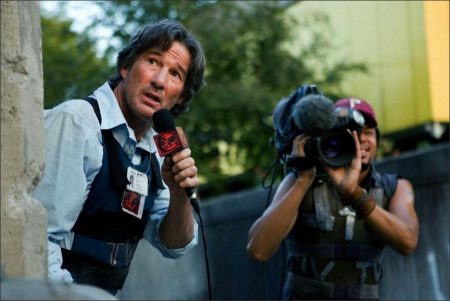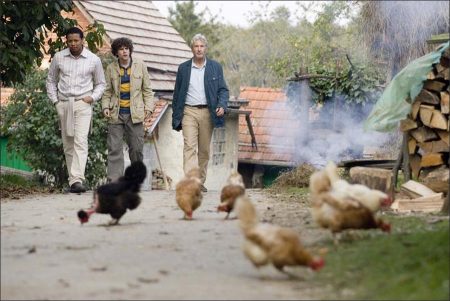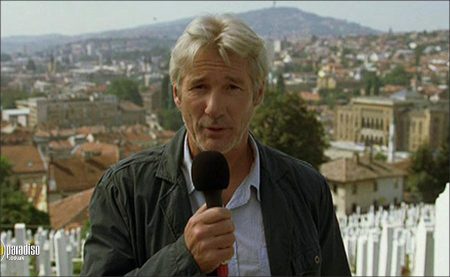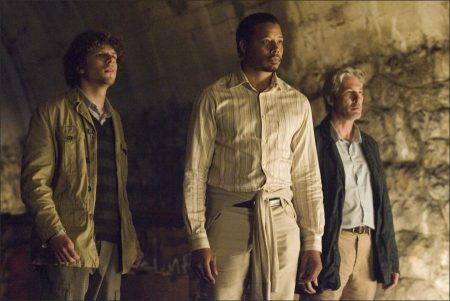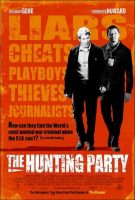Tagline: “In war what you see, and what really happened, are sometimes two very different things.”
TV News reporter Simon Hunt (Richard Gere) and cameraman Duck (Terrence Howard) have worked in the world’s hottest war zones: from Bosnia to Iraq, from Somalia to El Salvador. Together they have dodged bullets, filed incisive reports and collected Emmy awards. Then one terrible day in a Bosnian village everything changes. During a live broadcast on national television, Simon goes into meltdown. After that his high profile career is finished; Duck gets promoted and the two men part.
Five years later Duck returns to Sarajevo with rookie reporter Benjamin (Jesse Eisenberg) to cover the fifth anniversary of the end of the war. Simon shows up, a ghost from the past, with the promise of a world exclusive. He convinces Duck that he knows the whereabouts of Bosnia’s most wanted war criminal “The Fox”. Armed with only spurious information Simon, Duck and Benjamin embark on a dark and dangerous mission that takes them deep into hostile territory. It’s the scoop of a lifetime, but will they live long enough to report it,
The Hunting Party is a 2007 American action-adventure-thriller film with elements of political activism and dark satire starring Richard Gere, Terrence Howard, Diane Kruger and Jesse Eisenberg. The working title for this film was Spring Break in Bosnia before being changed to The Hunting Party during post-production. The Hunting Party had its world premiere at the 64th Venice International Film Festival on September 3, 2007. The movie turned out to be a huge disappointment domestically, grossing only US$969,869 in US theatres.
Shepard selected LA-based film composer Rolfe Kent to provide a full orchestral score. Kent responded to Shepard’s request for strong local color in the soundtrack by the use of Balkan motifs and percussion instruments. Kent also made use of Algerian singer Rachid Taha’s song Barra Barra from his album Made in Medina which had already featured in the 2001 film Black Hawk Down, and Pusti pusti modu by Serbian singer Zdravko Čolić, as well as material by Brian Keane with Omar Faruk Tekbilek. The soundtrack album was released on Lakeshore Records in 2007.
The Production Story
Sometimes the truth is stranger than fiction. Mark Johnson, a producer at Intermedia, discovered this firsthand when he met his friend Scott Anderson in late 2000.
Anderson, a well-known journalist, had recently returned from Bosnia and wrote of his experiences there for Esquire magazine. What I Did on My Summer Vacation was a classic if somewhat bizarre document of war reportage: an adventurous road trip that was black comedy, cautionary tale and trenchant political comment.
It told the story of Anderson and four other journalists who travelled to Bosnia earlier that year. All five had worked as reporters in the Balkans during the war. Five years after the cessation of hostilities, in the summer of 2000, they returned to Sarajevo.
Over a night of swapping stories, drinking beer and catching up they had an inspired, if somewhat absurd, idea. Why not track down and capture the war criminal Radovan Karadicz? With the help of a disaffected Serb police officer, who believed the journalists were a CIA hit squad, the five set about tracking down the most wanted man in Europe. Then the real CIA showed up.
After reading the Esquire article – and absorbing its movie potential – Johnson met with Anderson and the other two US journalists John Falk and Sebastian Junger (Philippe Deprez and Harald Doornbos completed the quintet) in Los Angeles. “They pitched me a story based on their encounters in Bosnia,” says Johnson. “Scott had written the article and they wanted to write a screenplay. I loved the story. It had a great deal of humor and at that time it also had elements of The Third Man. So after we set it up at Intermedia, the three of them set out to write a screenplay.
For a while the project was put on the backburner. Then Scott Kroopf, who had recently joined Intermedia, got involved. “My objective at the company was to look for more interesting, independent-oriented movies,” says Kroopf. “So when I looked at the article I thought, well this is great and it really is a question of finding the right tone and the right film maker.
Alex Litvak, at Intermedia suggested Richard Shepard. The New Yorker had recently written and completed shooting The Matador, a black comedy in which Pierce Brosnan played an ageing hit man. “It was a popular hit, a witty combination of drama, comedy and character study,” says Kroopf, “Not only is Richard a great writer but he did a fantastic job of directing and got an unbelievable performance out of Pierce Brosnan.”
After the success of The Matador, Richard Shepard was already juggling with some new ideas. “I was really interested in making a movie set in a post-war city,” he says. I was on the prowl for something like The Third Man, which is one of my favorite movies. That was set in Vienna after World War II. I was talking with several people about this concept.”
When initially approached by Johnson and Kroopf, Shepard balked. “At first I was terrified because I did not know enough about the subject or about Bosnia, but they urged me to read it,” says Shepard. “That article was so intriguing that I got interested. Then I said to Intermedia “Why don’t you send me to Sarajevo and I’ll see for myself?’”
Dressed to Impress
“The script intrigued me because it was written with a dark, cynical humor and as a costume designer I was interested in doing a special costume for the three journalists, Simon, Duck and Benjamin,” says costume designer Beatrix Pasztor.
Together with her assistant, Blanka Budak, Pasztor visited the Central Library in New York. “We researched the war in the Balkans and also looked at the various images of war reporters,” she says. “Then I researched wars from other countries like Sierra Leone and Somalia for the montage sequence.”
To determine the journalists’ wardrobe they spoke with Philippe Deprez and the other reporters. “Talking to the actual war reporters was very useful as it helped us to achieve in some respects a semi-documentary style,” she says. “But also because there is a black humor going through the movie there is this tension between the images – a contrast between the documentary style reality and the characters themselves who have a sort of hyper reality. That is reflected in the movie and particularly in the three main characters. They have a colour scheme that suggests their traits and individuality.”
The fitting for the three lead actors took place in a single day in New York. It was a buzz of activity, suggestion and innovation with Richard Shepard heavily involved. “We went through each costume a number of times,” says Pasztor. “Richard ensured that it was historically accurate and also he was involved in terms of the artistic elements, suggesting various colour schemes that would reflect the moods of the movie as well as the principal characters.”
Simon
“We went for simple when dressing Simon. In the beginning he has a favorite shirt and a favorite jacket. This jacket is an unusual colour – a sort of turquoise blue that was suggested by Richard Shepard. He wears the same pair of pants essentially throughout the film. For Simon clothes are really functional: khaki shirt, grey trousers but a distinctive jacket. He stayed very simple in dress which is probably very true to war reporters because they don’t change clothes that much as they are moving from place to place. Plus they also want to blend into the places that they are working – for them their attire is a sort of camouflage.”
Duck
“Richard Shepard saw Duck as a more rock & roll character but Terrence came to the fitting and started pulling out all these interesting pieces. In other words he started doing his own costume design and styling. He had great ideas and wanted to wear a bandana. In the beginning of the movie, where Duck is just starting out in his character, his look is very distinctive and gung ho and later on he becomes much more business-like and corporate. When he arrives in Sarajevo five years on he embarks on the trip wearing a ridiculous white outfit. Shepard liked that look and it added to the comedy of the scenes”
Benjamin
“Richard Shepard didn’t want Benjamin to look too nerdy. In the beginning he wears a skinny tie and a striped shirt just like a college student. Later on he loses that image and wears a green polo and blue corduroys so he is not so preppy any more.”
The gangsters were dressed in standard issue costume, what Pasztor calls “the tracksuit look.” But the main baddies, including The Fox, stand out from the pack. “I saw the Fox as a composite of all these bad guys, part Radovan Karadicz but also other war criminals,” she says. “At first we thought that he might have a bit of the Robin Hood character about him, someone who dressed poorly even though he had a lot of money but we decided that he would dress well because he is a peacock type of person, someone who likes to show off. That’s the man who ended up in the movie in the end.”
“For his lieutenant, the Nine-Fingered Man, Shepard suggested an actor with red hair. So you have this couple in the forest – the red-haired man and the Fox – so that was visually interesting. Also the midget was unusual. It took a long time to get his outfit right. We tried a number of things but we ended up with a salmon pink colour for him somehow. Richard Shepard always pushed the envelope which was very good.”
Creating a unique look for the various scenes in the battle montage was closely allied to costume and fitting out the various warring factions whether Somali, Iraqi or Palestinian in a defining wardrobe. “Those scenes were from different countries so Richard Shepard wanted each look to be very distinctive,” says Pasztor. “Even if it isn’t the precise and correct uniform at least it looks like it is from a different country.
For example with the Somali forces we showed him various photographs and he decided that the dominant colour was going to be red and orange. In another country the rebels were in rain ponchos so they were dressed in blue. We wanted to differentiate the factions using colours.”
For Pasztor, shooting the film on location in Croatia and Sarajevo had a profound impact on her understanding and therefore her work. “Our assistant’s little sister was injured and her father was killed in the war,” she says. “For her it was living through the whole experience again. But she also knew that this was an important movie to make. Shooting it in Sarajevo really helped us to get a sense of the reality of what the war was really like.”
Continue Reading and View the Theatrical Trailer
The Hunting Party (2007)
Directed by: Richard Shepard
Starring: Richard Gere, Terrence Howard, Jesse Eisenberg, James Brolin, Diane Kruger, Joy Bryant, Kristina Krepela, Lejla Hadzimuratovic, Olja Hrustic, Harald Doornbos
Screenplay by: Richard Shepard
Production Design by: Jan Roelfs
Cinematography by: David Tattersall
Film Editing by: Carole Kravetz Aykanian
Costume Design by: Beatrix Aruna Pasztor
Set Decoration by: Anuradha Mehta
Art Direction by: Mario Ivezic
Music by: Rolfe Kent
MPAA Rating: R for strong language and some violent content.
Distributed by: The Weinstein Company
Release Date: September 7, 2007
Visits: 84
